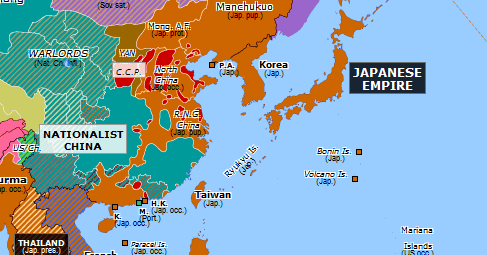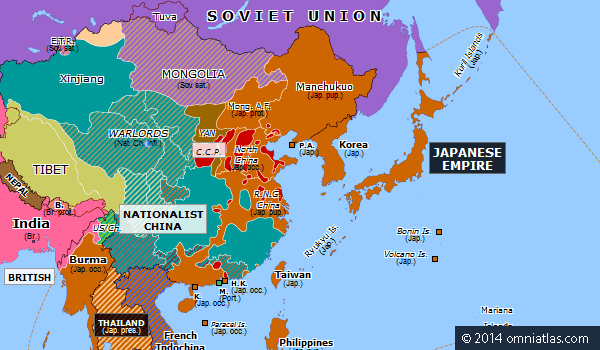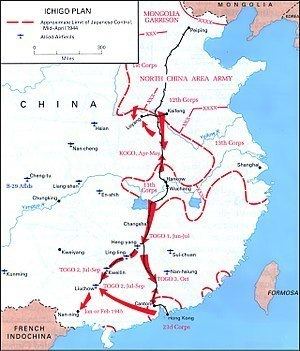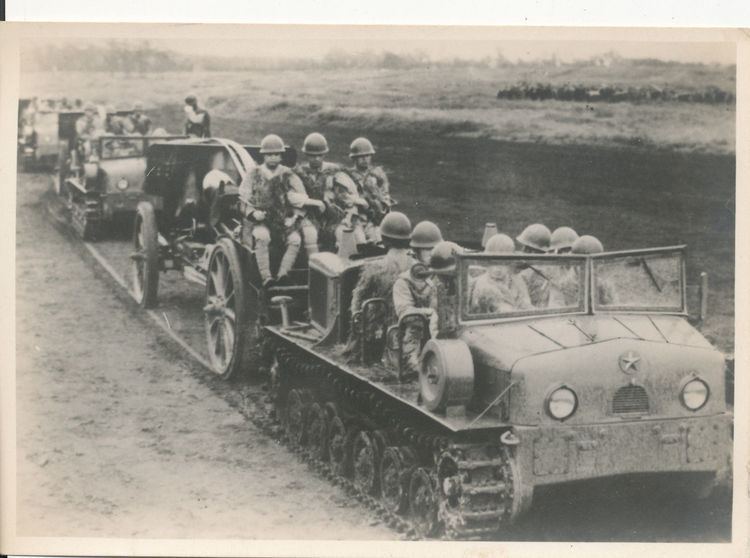Dates 17 Apr 1944 – 10 Dec 1944 | ||
 | ||
1,000,000 500,00015,000 vehicles6,000 artillery pieces800 tanks100,000 horses Similar | ||
Penang in asia lecture series operation ichigo china s turning point
Operation Ichi-Go (一号作戦 Ichi-gō Sakusen, lit. "Operation Number One") was a campaign of a series of major battles between the Imperial Japanese Army forces and the National Revolutionary Army of the Republic of China, fought from April to December 1944. It consisted of three separate battles in the Chinese provinces of Henan, Hunan and Guangxi.
Contents
- Penang in asia lecture series operation ichigo china s turning point
- Course of the campaign
- Aftermath
- In popular culture
- References

These battles were the Japanese Operation Kogo or Battle of Central Henan, Operation Togo 1 or the Battle of Changheng, and Operation Togo 2 and Togo 3, or the Battle of Guilin-Liuzhou, respectively. The two primary goals of Ichi-go were to open a land route to French Indochina, and capture air bases in southeast China from which American bombers were attacking the Japanese homeland and shipping.

In Japanese the operation was also called Tairiku Datsū Sakusen (大陸打通作戦), or "Continent Cross-Through Operation", while the Chinese refer to it as the Battle of Henan-Hunan-Guangxi (simplified Chinese: 豫湘桂会战; traditional Chinese: 豫湘桂會戰; pinyin: Yù Xīang Guì Huìzhàn).

Course of the campaign

There were two phases to the operation. In the first phase, the Japanese secured the Pinghan Railway between Beijing and Wuhan; in the second, they displaced the US air forces stationed in Hunan province and reached the city of Liuzhou, near the border with Japanese-held Indochina. 17 divisions, including 500,000 men, 15,000 vehicles, 6,000 artillery pieces, 800 tanks and 100,000 horses participated in this operation.
The Japanese included Kwantung Army units and equipment from Manchukuo, mechanized units, units from the North China theater and units from mainland Japan to participate in this campaign. It was the largest land campaign organized by the Japanese during the entire Second Sino-Japanese War. Many of the newest American-trained Chinese units and supplies were forcibly locked in the Burmese theater under Joseph Stilwell set by terms of the Lend-Lease Agreement.
In Operation Kogo, 390,000 Chinese soldiers, led by General Tang Enbo (湯恩伯), were deployed to defend the strategic position of Luoyang. The 3rd Tank Division of the IJA crossed the Yellow River around Zhengzhou in late April and defeated Chinese forces near Xuchang, then swung around clockwise and besieged Luoyang. Luoyang was defended by three Chinese divisions. The 3rd Tank Division began to attack Luoyang on May 13 and took it on May 25.
The second phase of Ichigo began in May, following the success of the first phase. Japanese forces advanced southward and occupied Changsha, Hengyang, Guilin and Liuzhou. In December 1944, Japanese forces reached French Indochina and achieved the purpose of the operation. Nevertheless, there were few practical gains from this offensive. US air forces moved inland from the threatened bases near the coast. The operation also forced British Commandos working with the Chinese as part of Mission 204 to leave China and return to Burma. The U.S. Fourteenth Air Force often disrupted the Hunan–Guangxi Railway between Hengyang and Liuzhou that had been established in Operation Ichigo. Japan continued to attack airfields where US air forces were stationed up to the spring of 1945.
The XX Bomber Command operating Strategic B-29 bombers of the Twentieth Air Force, which were attacking Japan in Operation Matterhorn, were forced to move as well, but although this affected their efficiency for a short time, in early 1945 the Twentieth Air Force moved to newly established bases in the Marianas under the command of the newly established XXI Bomber Command. This nullified the limited protection that the Japanese home islands had received from Operation Ichigo.
Aftermath
With the rapid deterioration of the Chinese front after Japanese launched Operation Ichi-Go in 1944, General Joseph Stilwell saw this as an opportunity to win his political struggle against Chiang Kai-shek, China's leader, and gain full command of all Chinese armed forces. He was able to convince General George Marshall to have President Franklin D. Roosevelt send an ultimatum to Chiang threatening to end all American aid unless Chiang "at once" placed Stilwell "in unrestricted command of all your forces."
An exultant Stilwell immediately delivered this letter to Chiang despite pleas from Patrick Hurley, Roosevelt's special envoy in China, to delay delivering the message and work on a deal that would achieve Stilwell's aim in a manner more acceptable to Chiang. Seeing this act as a move toward the complete subjugation of China, a defiant Chiang gave a formal reply in which he said that Stilwell must be replaced immediately and he would welcome any other qualified U.S. general to fill Stilwell's position. As a result, Stilwell was replaced as Chief of Staff to Chiang Kai-shek and commander of the U.S. Forces, China Theater (USFCT) by Major General Albert Wedemeyer. His other command responsibilities in the China Burma India Theater were divided up and allocated to other officers.
Although Chiang was successful in removing Stilwell, the public relations damage suffered by his Chinese Nationalist Party (Kuomintang) regime was irreparable. Right before Stilwell's departure, New York Times drama critic-turned-war correspondent Brooks Atkinson interviewed him in Chungking and wrote:
The decision to relieve General Stilwell represents the political triumph of a moribund, anti-democratic regime that is more concerned with maintaining its political supremacy than in driving the Japanese out of China. The Chinese Communists... have good armies that they are claiming to be fighting guerrilla warfare against the Japanese in North China—actually they are covertly or even overtly building themselves up to fight Generalissimo's government forces... The Generalissimo [Chiang Kai-shek] naturally regards these armies as the chief threat to the country and his supremacy... has seen no need to make sincere attempt to arrange at least a truce with them for the duration of the war... No diplomatic genius could have overcome the Generalissimo's basic unwillingness to risk his armies in battle with the Japanese.
Atkinson, who had visited Mao Zedong in the communist capital of Yenan, saw his Communist Chinese forces as a democratic movement (after Atkinson visited Mao, his article on his visit was titled Yenan: A Chinese Wonderland City), and the Nationalists in turn as hopelessly reactionary and corrupt. This view was shared by many U.S. journalists in China at the time, but due to pro-Chiang Allied press censorship, it was not as well known to their readers until Stilwell's recall and the ensuing anti-Chiang coverage forced it into the open.
The Japanese successes in Operation Ichi-Go had a limited effect on the war. The U.S. could still bomb the Japanese homeland from Saipan and other Pacific bases. In the territories seized, Japanese forces controlled only the cities, not their surrounding countryside. The increased size of the occupied territory also thinned out the Japanese lines. A great majority of the Chinese forces were able to retreat out of the area, and later come back to attack Japanese positions. As a result, future Japanese attempts to fight into Sichuan, such as in the Battle of West Hunan, ended in failure. All in all Japan was not any closer in defeating China after this operation, and the constant defeats the Japanese suffered in the Pacific meant that Japan never got the time and resources needed to achieve final victory over China. The Japanese suffered 11,742 KIAs by mid-November, and the number of soldiers that died of illness was more than twice this. The total death toll was about 100,000 by the end of 1944.
Operation Ichi-go created a great sense of social confusion in the areas of China that it affected. Chinese Communist guerrillas were able to exploit this confusion to gain influence and control of greater areas of the countryside in the aftermath of Ichi-go.
In popular culture
The 1958 novel The Mountain Road, by Theodore White, a Time magazine correspondent in China at the time of the offensive. It was based on an interview with former OSS Major Frank Gleason who led a demolition group of American soldiers during the offensive that were charged with blowing up anything left behind in the retreat that might be of use to Japan; his group ultimately destroyed over 150 bridges and 50,000 tons of munitions, helping slow the Japanese advance. In 1960 it was adapted into a film starring James Stewart and Lisa Lu, noteworthy for being one of Stewart's only war films and the only one where he plays a soldier, as he was opposed to war films due to their inaccuracy. It is generally believed he made an exception for this film because it was anti-war.
